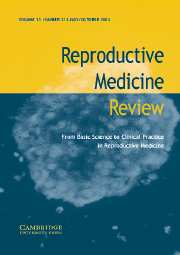Article contents
GnRH analogues in the treatment of fibroids
Published online by Cambridge University Press: 02 March 2009
Extract
Uterine fibroids are estimated to affect up to 25% of women of reproductive age and are a common cause of morbidity, being associated with menstrual dysfunction, iron deficiency anaemia, pregnancy wastage and subfertility. Their pathogenesis remains unknown but their association with ovarian function and oestrogen production is undisputed and supported by their occurrence only after puberty and the shrinkage observed after the menopause. This oestrogen dependency has recently been exploited therapeutically through investigation of the use of agents that induce a hypo-oestrogenic state, the gonadotrophin-releasing hormone (GnRH) or luteinizing hormone-releasing hormone (LHRH) analogues.
- Type
- Articles
- Information
- Copyright
- Copyright © Cambridge University Press 1993
References
- 5
- Cited by


